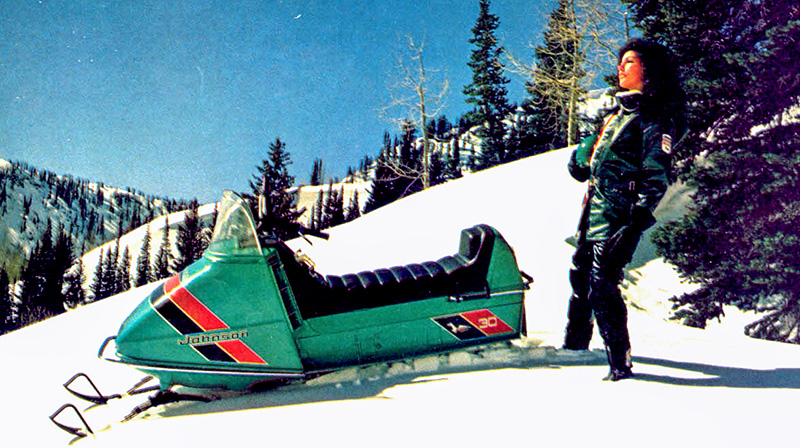The first Yamaha to carry the SRX model designation was the company’s 1974 Sno Pro racer, with very few units handcrafted for the fledgling professional racing circuit. They weren’t big winners or the most publicized Sno Pro sleds and most snowmobilers never even saw one.

The SRX designation was not used in 1975. It returned in 1976 and ’77 for Yamaha’s race-ready oval sprint sleds that were offered in limited numbers to qualified independents for the “Stock” class competition of the time. Built to go fast and turn left until there was no more hundred-plus octane aviation gas remaining in the tiny 2.6-gallon fuel tank, the sleds had aluminum skis, a tachometer (a speedometer was optional), no windshield and only a pretense of trail-ability.
Ed Schubitzke electrified the snowmobile world by winning the 1976 Eagle River World Championship on a slightly modified SRX – a truly incredible performance for a stock snowmobile that would run with the best of the modified race sleds from the other brands. “Fast Eddie,” Bobby Donahue, Dick Trickle, Bob Hulsebus, Oscar St. Onge and numerous others went on to compile an enviable competition record with the ’76 and ’77 SRX racers. In addition, factory driver/ engineer Morio Ito and his mechanic Tom Marks used an SRX as their test mule for coil-over-shock suspension development for the forthcoming SSR oval racer.
From The Track To The Trails
In 1978, the SRX became a trail model available to anyone who wanted to purchase one. Positioned as a lake runner, the first liquid-cooled Yamaha trail sled retained the basic appearance of the earlier stock racers, but in many details it was a different machine.
Numerous components were strengthened – including the jackshaft, the driveshaft and the skid frame (which was beefed up with more travel). Skis were steel. Engine cooling was accomplished with the same system of a small radiator and heat exchangers, but the tunnel-mounted exchangers were lengthened for increased cooling capacity. Belly pan vents also helped cooling. Steel cleats were deleted from the molded rubber track. The seat looked the same, but was actually a new design. Full instrumentation was provided and a 7-gallon gas tank was fitted, as was a short windshield.

The new 440 engine was engineered to run longer than what was needed for oval sprint racing. Using the 1977 SRX engine base and crankshaft with different cylinders that featured less aggressive port timing, the new engine had smaller Mikuni VM series carbs, a lower 7.7 to 1 compression ratio and a less aggressive ignition curve. It produced about 80 hp on premium pump gas instead of hard-to-find aviation fuel and it could be built up to crank out lots more power. But unlike all the other Yamaha trail sled motors, this engine retained the pre-mix lubrication system of its racetrack predecessors.
With the basic formula established, the SRX quickly became a favorite of the serious go-fast crowd on tracks, lakes and trails.
The 1979 version was quite similar to the ’78, but there were some significant powertrain changes. The engine was reconfigured to run on regular gas while retaining the 80 hp output by reworking the pistons and further reducing the compression ratio to 7 to 1. But unlike other Yamaha trail sleds, it still required premixed oil and gas. Heat exchanger capacity was expanded again and the new YP drive clutch was fitted. The hood color changed from the traditional Yamaha white to jet-black.
“Beat Thy Neighbor”
For 1980 Yamaha decided it could have its cake and eat it too by making the SRX more palatable to the average trail rider. It was promoted as the sled to keep up with “the Joneses, or the Johanssens, or the Jovanoviches”
Addition of Yamaha’s Autolube oil injection eliminated the fuss and mess of pre-mixed fuel, but also reduced user control of the gas-oil mix. Easier-pulling Mikuni butterfly carbs replaced the traditional VM-series units. The drive clutch was upgraded, new nitrogen-charged shock absorbers were used and the belly pan vents were eliminated even though preproduction photos showed them. The race-required tether switch was an option. Gold was introduced as a trim color, with the tunnel and belly pan gold-anodized for an unmistakable new appearance.
Some felt the previous pre-mix version ran stronger. “When I bought mine, my dealer told me that knowing what I was going to use it for, he thought I’d be happier with a leftover ’79,” recalled New York ice drag racer Tony Bellucco.
However, the 1980 model was definitely a sales success and Yamaha continued to build market share with the SRX as its trail performance image leader. Autolube gave it a convenience advantage over every other hot trail sled on the market and it’s appearance and actual performance ensured that Yamaha was taken very seriously in the increasingly important trail racer market.
Editor’s Note: Every issue of Snow Goer magazine includes in-depth sled reports and comparisons, aftermarket gear and accessories reviews, riding destination articles, do-it-yourself repair information, snowmobile technology and more! Subscribe to Snow Goer now to receive issues delivered to your door 6 times per year for a low cost.







